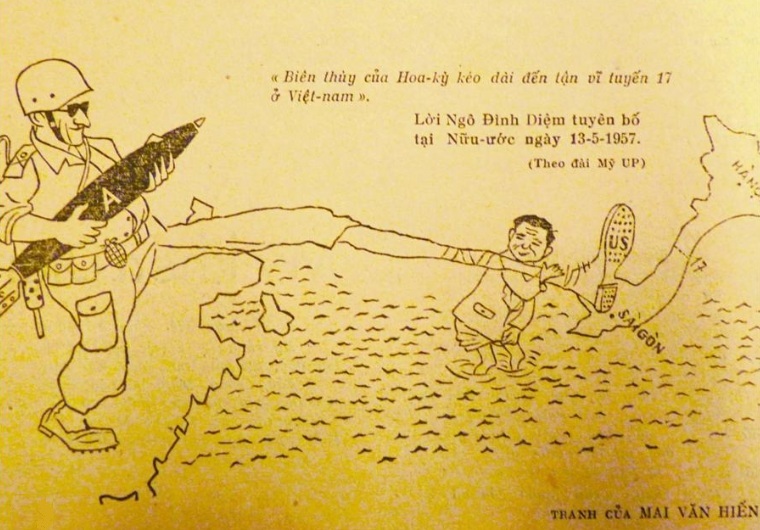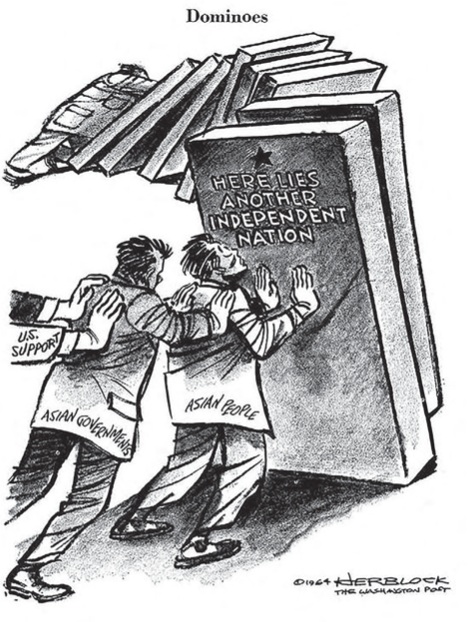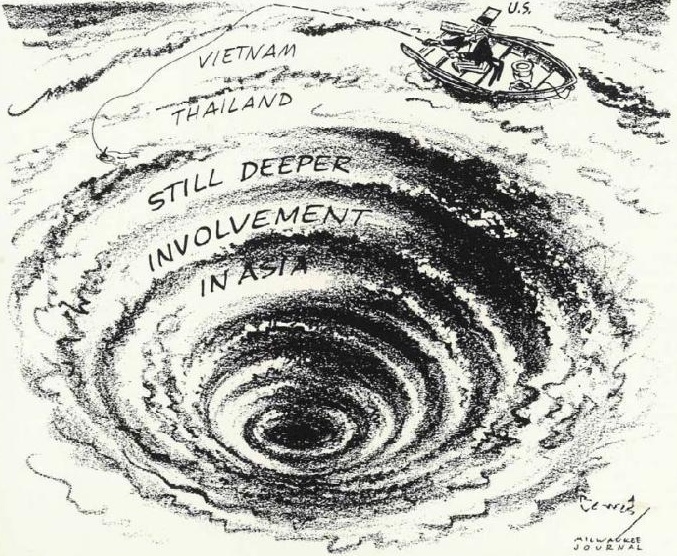|
|
|
Source A
|
Going DeeperThe following links will help you widen your knowledge: Basic accounts from BBC Bitesize
YouTube Report on the Gulf of Tonkin Incident - President Johnson, 4 August 1964 The Gulf of Tonkin incident - Mr Cloke
|
|
A propaganda cartoon by the well-known North Vietnamese political cartoonist Mai Văn Hiến (1957).
|
Consider:Interpret Source A. What are its messages? How effective is it as a piece of propaganda? Why, in Hien's opinion, did the US enter the war in Vietnam?
|
Why did the US enter into the Vietnam War?The Local ContextWhen you studied the webpages on 'The End of French Colonial Rule' and 'South Vietnam under Ngo Dinh Diem' you were asked to "make a list of evidence which shows that the Americans were heavily involved in Vietnam".
Whilst the Americans might have only OPENLY gone to war in Vietnam in 1964, you will have realised that by 1963 they were already up to their necks in a secret proxy war there. The list of events shows clearly how the US involvement in Vietnam gradually grew, as: • The French were driven out. • In 1959 Ho Chi Minh declared a 'People's War' of liberation. • Diem was unpopular and the ARVN was losing to the VietCong.
|
Did You KnowWhy did the USA get involved in Vietnam?
|
The International Context• Hatred of Communism: the US saw itself as 'leader of the free world' and was committed to an ideological war against Communism, exemplified in the 'McCarthy Witch-hunt' of the 1950s, but also in Kennedy's 1961 election pledge to 'get tough' on Communism worldwide – Kennedy ended up sending 16,000 military personnel in Vietnam, but he tried to keep American involvement down to helping the ARVN with their an anti-guerrilla campaign. • The Cold War: after 1945 the US fought a worldwide 'Cold War' against Communism – on a number of occasions (notably the Berlin Blockade, the Korean War and the Cuban Missiles Crisis), the US threatened to conduct a nuclear war which would have destroyed humankind. The US suffered a huge setback in 1949 when China turned Communist. Then China and the USSR were supporting Ho Chi Minh, so the US HAD to support South Vietnam. • Strategic value:
• US policy: Over time, American aims hardened:
all these strategies required the US to double down on its determination to prevent Ho Chi Minh unifying Vietnam under Communist rule. • The Military-industrial Complex: American arms manufacturers wanted war. The US military budget, $53 billion in 1964, rose to $85 billion in 1969 ... allowing US companies such as Boeing and Lockheed Martin to make vast profits.
|
Source BCommunist control of all Southeast Asia would render the US position in the Pacific precarious and would seriously endanger fundamental US security interests in the Far East. Secret Memorandum of the US National Security Council (1952).
Source CWhy is Southeast Asia important? First, it provides fertile soil, rich natural resources, a relatively sparse population in most areas, and room to expand. It also produces rich exportable surpluses such as rice, rubber, teak, corn, tin, spices, oil and many others Speech to Detroit businessmen by the U.S.Undersecretary of State (1963).
Source D
The American cartoonist 'Herblock' explains the domino theory (1964).
|
The Gulf of Tonkin Resolution, 7 Aug 1964Source ERecently, North Vietnam has become more threatening. These latest attacks on our armed forces are not the first. Therefore, I am now asking Congress to agree that all future attacks will be responded to, and that the USA will continue to assist South Vietnam in defending its freedom. We do not seek to widen our involvement in Vietnam but we must show that we are determined to stop communist aggression. From President Johnson’s message to Congress on 5 August
1964.
On his election in 1964, President Johnson declared: "I am not going to be the President who saw South-East Asia go the way China went" – he was actively seeking an opportunity to become involved in the war. He described the North Vietnamese Communists as 'the bully at the porch': "If you let a bully come into your garden, next day he’ll be in your porch, and the day after that he’ll rape your wife". In July 1964, American forces helped the ARVN carry out raids on North Vietnamese radar stations. On 2 August 1964, the USS Maddox fired on North Vietnamese torpedo boats. The US military was on hgh alert; on the night of 3-4 August, sailors on the Maddox panicked, fearing they were under attack. Johnson did not believe that the North Vietnamese had attacked the Maddox – he said: ‘those dumb stupid sailors were just shooting at flying fish’ – and, later, he would call Vietnam "that bitch of a war" ... but in 1964 he told Congress that the North Vietnamese “had conducted deliberate attacks against US naval vessels” and sought enhaced powers to go to war. On 7 August 1964, Congress authorised him to increase American involvement. The entry of America directly into the war (= 'the USA will stop communism in Vietnam') is called by historians the 'Americanisation' of the war, to distinguish it from the policy of 'Vietnamisation' (= 'we will help the South Vietnamese stop communism in Vietnam') followed before 1964 and after 1969.
|
Source FThis attack on American warships is the consequence of our own aggressive actions. The President is now asking for powers to be able to move more of our armed forces into South Vietnam whenever he believes it necessary. This will involve Americans in a war in which we have no business, and which is quickly escalating. I am opposed to losing the life of any American soldier in Vietnam. We have lost far too many men already. From a speech made by Senator Gruening on 7 August 1964 during the Senate debate on the Gulf of Tonkin incident.
Source GThe Gulf of Tonkin incident was a turning point in the USA’s involvement in Vietnam. Before the ‘attacks’ on US warships, there were only 16,000 American military advisors in South Vietnam. A few years after, there were over 500,000 US soldiers fighting the communists. Before the Tonkin incident, the USA was already supplying South Vietnam with increasing amounts of money and arms. Both Presidents Eisenhower and Kennedy had fully committed the USA to defend South Vietnam’s independence. However, the incident gave Johnson an excuse to expand the USA’s involvement massively. From an article on the Gulf of Tonkin incident (2012).
|
EscalationOnce they had become involved, the Americans had to keep increasing their commitment so as not to lose the war. And the more they lost, the more they had to commit, because to back out would be to lose face. The historian Tony Howarth summarises: Where Kennedy had sent thousands of troops, Johnson sent tens, and then hundreds, of thousands; where Kennedy had spent tens of millions, Johnson poured out billions of dollars; where Kennedy had threatened, Johnson bombed. Just as Eisenhower had inherited and followed Truman’s strategy in Indo-China, and just as Kennedy had agreed with and developed Eisenhower’s policy, so LBJ accepted and then escalated Kennedy's commitment of men, money and materials to South Vietnam."
|
Source H
A cartoon by American cartoonist Ross Lewis in the Milwauke Journal, 1965
|
Consider:1. Why, do you think, did Kennedy keep his involvement in the war secret? 2. Looking at the run ofevents, which idea, do you think, had the greater effect on US policy: 'containment' or the 'domino theory'? 3. Which of the sources A-H, do you think, provides the most accurate statement of US motives? Explain/justify your decision. 4. Make a list of all the reasons you can find (and infer) as to why the US embarked on open war in Vietnam in 1964. In discussion, rank them in order of importance. Turn your list into an essay plan, providing 'proving evidence' and an explanation for each reason. 5. Discussion: Source H shows the Americans
getting dragged helplessly ever deeper into the whirlpool of a war in
Vietnam.
|
|
|
|
|
|
Spotted an error on this page? Broken link? Anything missing? Let me know. |
|


